Motorcycle Character
Before choosing the new Triumph Speed Triple RS motorcycle, I had test
ridden a number of 'full on' sports bikes like the BMW S1000RR, the
Suzuki GSX-R1000 and the Honda Fireblade SP as well
as some 'naked' sports bikes, like the BMW S1000R. The Speed RS had the
character I wanted, it was something special on the road. The only other
motorcycles that came near to it (for character) were the Aprilia Tuono
1100 Factory and the Triumph Street Triple RS.
Please note that this review will grow as I expand on more information
regarding the RS and my use of the motorcycle.
Some information is repeated within
the review for continuity as some readers might select to read only
certain parts. If you wish, you can skip the review, which could be
construed as heavy going and just head for my
Summary of the Triumph Speed Triple RS at the end.
The review relates to two Triumph Speed Triple RS motorcycles. My first
one purchased on the 5th May 2018 developed an oil flow pressure problem during its 500 mile service due to its oil
change. This was not the fault of the Triumph Dealer, it was a wrinkle
in the oil system which caused a vacuum and was later resolved by
Triumph. I rejected the RS and within a few weeks, on the 23rd June
2018, I received a second brand
new RS which has now covered in excess of 3,600 miles. Throughout the
entire experience, I cannot fault the Dealer Salesman and the Technical
Director who treated me with the
utmost respect and went out of their way to ensure a smooth transition
to my second motorcycle.
I also have a Suzuki GSX-1250FA which I purchased new back in 2014 after
I passed my test. I alternate it's use with my RS.
-
Smart Keyless Ignition Key Fob (Includes Emergency Bypass)
-
Triumph Datatool Alarm System (Includes Emergency Bypass)
-
General Information - Includes Maintenance/Warranty - Running In - Early Riding Experience
-
Riding Modes Controls + Continental Inertial Measurement Unit + Riding Modes Table
-
Pirelli Supercorsa SP Tyres & Alternative Pirelli Tyre Choice
-
26th May 2020 - RS Recall Notice - Replacement Front Brake Pads
-
25th August 2021 - Thoughts on the New Triumph Speed Triple 1200 RS
-
14th March 2022 - New Batteries for the Key Fob and Alarm Fob
Motorcycle Delivery - List of Accessories
I have taken delivery of my 1st
2018 Triumph Speed Triple RS (5th
May 2018) and I
added a few extras which you can view in some of the images below -
-
Triumph Alarm System
-
Datatag (Security Tags Placed on Parts of the RS & Registered on the Datatag Database)
-
Triumph Up/Down Quickshifter
-
Triumph Front Fork Protectors
-
Triumph Rear Seat Grab Handle
-
Triumph Smoke Tinted Fly Screen
-
Techspec Generic SS Snakeskins (Cut to Shape for the Sides & Top of the Tank)
-
Scottoiler for Automatic Oiling of the Chain
-
R&G Aero Sliders
-
Evotech-Performance Radiator & Oil Cooler Protectors
-
Optimate 4 Battery Charger
-
Oxford Boss 16mm Alarm Padlock for the Front Disc
-
BikeTek Rear Wheel Paddock Stand
I was well pleased, the salesman and the service department did a splendid job of preparing the motorcycle and explaining the controls.
Dealership & Manufacturer Relationship
I firmly believe in supporting my local dealership
and in the long-term and at the end of
the day, the ongoing relationship between yourself,
the service department and
of course,
the
motorcycle brand manufacturer
is critical. Confidence building is
essential because if you lose confidence in the model build from the
manufacturer or the service department's ability to maintain your
motorcycle properly, it can place you at a loss as to where to turn
to, especially if you cannot afford to trade in your new motorcycle for
a different brand.
Purchasing a new motorcycle must be given careful consideration as the 2
or 3 years warranty BINDS you to the manufacturer and the brand
dealership for the servicing, manufacturer recalls and any warranty
repairs, Thereafter, when the warranty has run out, you can if you wish,
take your motorcycle to a third party servicing department.
New models of motorcycles, just like cars, can have their teething
troubles and honesty from the manufacturer and the dealership has always
been the best policy in addressing them and reassuring the customer.
Scottoiler (Drips Small Amounts of Oil on the Chain)
The Triumph Dealer, who supplied the
motorcycle, did a great job in concealing the Scottoiler behind the left
side of the frame next to the rear suspension adjustment controls. Its a
sports version (quite small) but it holds a fair amount of oil which
drips very slowly onto the chain when the RS is running. Its just a
matter of keeping an eye on the system to ensure it is working and for
topping up the oil.
(see images below)
R&G Aero Sliders - Crash Protection
I purchased the Aero Sliders from R&G online and the Triumph Dealer
fitted them for me.
There
are two positions for the R&G Aero Sliders, one is behind the radiator
but I opted for a more central position on the bike, near to the seat.
NOTE: If ordering the R&G sliders, beware that there are two
kits, one for the front and one for the centre position - they have
different spacers. ALSO when fitting to the centre position - remember
to keep the original bolts taken off the RS in a safe place.
(see images below)
Triumph Front Fork
Protectors
- Crash Protection
I had the Triumph front fork protectors fitted by the Triumph Dealer.
There were other choices available from 3rd parties, but I think the
Triumph variant suited the RS more than the others.
(see images below)
Triumph 'Smoked' Fly Screen
I had the Triumph 'smoked' fly screen fitted by the Triumph Dealer and
not only is it a very nice piece of 'eye candy' which finishes of the
look of the RS but it appears to be effective. On a private road, I hit
105mph at 11,000 revs in 3rd gear and at no time did I feel
the wind blast was unsettling me or preventing me from enjoying the
moment. I was not tucked down on the tank but slightly more crouched
forward to deal with the massive acceleration. (see images below)
Triumph Rear Seat - Cowl
When you purchase the RS, Triumph also supply a cowl in matching
red/black colour to fit to the bike to replace the rear seat. It is a
cracking piece of 'eye candy' and I should really fit mine because it
gives the RS a more sporty appearance. I will probably get around to it
as it is languishing in a cupboard.
NOTE: If you are having an Triumph alarm fitted, make sure that the
Dealer gives you the alarm sensor for the cowl. It is normally supplied
separately with a couple of self tapping screws. I fitted the sensor
immediately even although I am not using the cowl - saves the sensor
getting lost over time.
Triumph 'Rear Seat' Grab
Handle
I had the Triumph grab handle fitted behind the rear seat but not for
strapping a bag to. First of all, it is a sturdy piece of kit and
because I am not a fan of moving a motorcycle about in my garage using
the bars - I use the left bar grip and the grab handle. I really like it
the most for holding onto with my left hand to straighten the RS
upright, whilst raising/lowering the RS rear wheel on my BikeTek paddock
stand - makes it a breeze for single person operation.
(see images below)
Additional Security - Alarm Padlock for Front Disc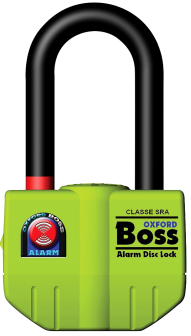
My Triumph Speed Triple RS is fitted with an
(optional) Triumph Alarm System but I also ordered an
Oxford Big Boss 16mm Alarm Lock - OF4 Model
for locking the front
wheel whilst in the bike's steering lock position.
It is a large device but I carry it in a waterproof textile pouch
(a Lowepro Slip Lock Pouch) attached to the left side of the frame
(small black cable ties) just
in front of my leg.
The Oxford Alarm Padlock just fits the front disc by a
small margin (must be fitted into the narrowest part of the disc).
Additional Security - Datatag Motorcycle Parts
I also requested the Triumph Dealer to Datatag the various parts of my
RS that could be broken up for spares if the motorcycle was stolen. I
put the Datatag label on the tank at the front where it could easily be
seen and act as a deterrent.
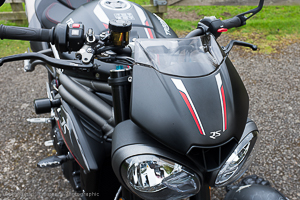
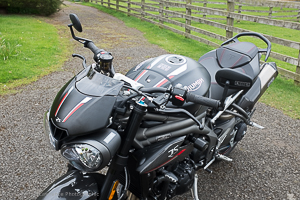
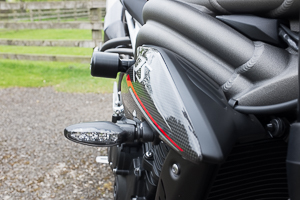
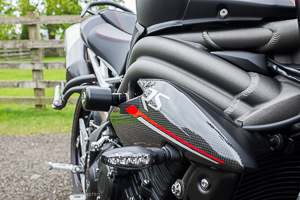
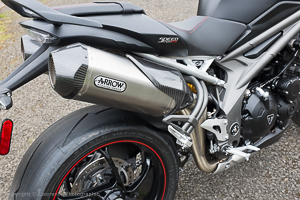
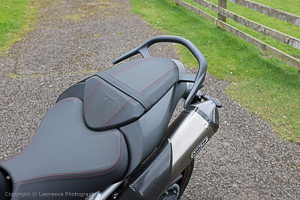
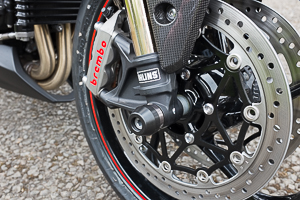
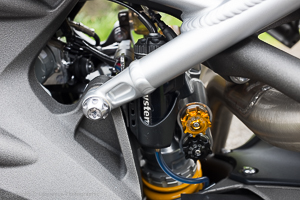
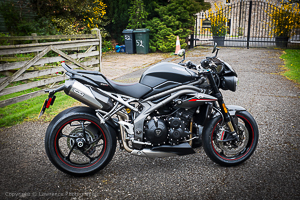
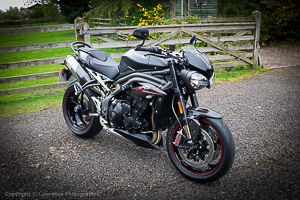
Triumph Alarm System - Excellent Security
As a condition of my insurance, I have to set the Triumph Alarm when the
motorcycle is left unattended and even in my locked garage. I don't know
how long the battery will hold charge with the alarm set but in any
case, the bike will be in storage over the winter period and I also use
another motorcycle, so the Triumph will be sitting with the alarm
draining the battery.
Hence the requirement for an Optimate 4 to trickle charge the battery
when the Triumph is in the garage.
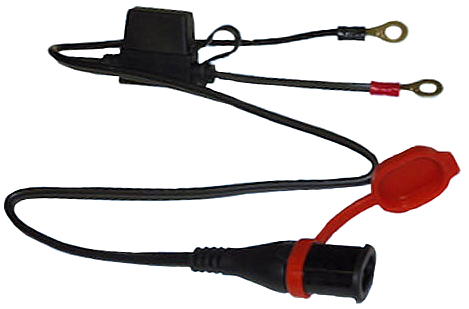
This video is a good example of how to fit the Optimate Flying Lead to the battery - NOTE: The new Optimate 4 Flying Lead, has a different (more waterproofed) plug connector - see image above.
The Triumph Alarm System is a Thatcham Category 1 approved - so when you
switch off the engine and shut down the ignition, the alarm will
automatically set within a few seconds. Not the full alarm but the
immobiliser. However, if you enter the garage, switch off the alarm and
you are in the process of moving the motorcycle outside (engine has not
been switched on) the full alarm system will reset and then activate,
due to the movement of the bike. I now
start the engine and then switch it off before moving the motorcycle
outside - during the process, the immobiliser sets but not the full
alarm - then when I am ready to start the bike, I have to use the alarm
key fob to switch the immobiliser off. Its a small price to pay for
great security.
Normal setting of the alarm is easy - switch off engine and ignition,
turn the front wheel to left/lock position and press the lock steering
button on top of the right controls cluster (image below) and
you will hear a short hiss/click as the steering lock engages (check steering
is locked by attempting to gently move the front wheel). Now, within a few seconds press the grey button on the alarm fob and the
indicators flash twice to set the full alarm system. To unset, press the grey button on the alarm fob
and the indicators flash once - must start engine within a few seconds
or the alarm will automatically set the immobiliser. NOTE: When
you engage the ignition to start the engine, the steering lock makes a
short hiss/click as it automatically unsets.
Alarm Emergency Bypass Solutions
(Alarm Fob or Fob Battery Fails)
To avoid the battery failing (it lasts approximately 12 months) - on the
odd occasion test the alarm fob battery by disarming the alarm 10
metres from the bike and when you notice the test distance starting to
reduce before the fob works, replace the battery.
If the alarm fob or the fob battery fails whilst out on a run - there is a
solution available to circumvent the alarm system and start the bike.
IMPORTANT NOTE:
The bike's smart keyless
ignition fob must be in your pocket (switched to
GREEN/ON) before you
can bypass the alarm using your alarm pin code to start the bike:
-
When you first purchase the RS, use the alarm Datatool Manual and program your own 4 pin code into the alarm main control unit (situated within the bike) using the ignition switch. If your alarm key fob fails, you press the bike's on/off switch and then set the ignition on - the alarm will sound for 30 seconds. You then insert your pin code using the ignition switch and then start the bike within 45 seconds or the alarm immoboliser will activate. After you have started the bike and then switched it off - the alarm immoboliser will kick in (within 45 seconds) and to start the bike again, you will have to go through the pin code insertion procedure. NOTE: Datatool provides a small plastic card for your wallet with the relevant pin code deactivation instructions.
-
You can purchase a CR1616 spare battery and a small hex screwdriver to open up the alarm key fob and replace the battery. You can keep these under the bike's seat in a waterproof pouch. NOTE: I cannot confirm this will work as I prefer the pin code method, which I have tested.
NOTE: If you are having an Triumph alarm fitted, make sure that the Dealer gives you the alarm sensor for the rear seat replacement cowl that is supplied with the RS. It is normally supplied separately with a couple of self tapping screws. I fitted the sensor immediately even although I am not using the cowl - saves the sensor getting lost over time.
The alarm fob is the small one with the grey button (see images below). The large fob is the electronic unit for enabling the bike's ignition (must be on your person or near the bike for the ignition to work). The second image shows the key for unlocking the petrol tank and rear seat - works like a flick knife, press the chrome button on the large fob and the key flicks out. To close into fob, simply press back home. The blue key is for my Oxford Padlock Alarm.
BikeTek (Single Swingarm)
Rear Paddock Stand
(One Person Operation)
The BikeTek rear paddock stand is a substantial piece of kit, fitting it
on the RS rear wheel is easy - put the bike on its side stand, slip
the paddock stand pin into the rear wheel axle (left side) and slide it
home. Using the rear grab handle, raise the bike level which allows both
wheels of the paddock stand to rest on the ground. Using this method,
the paddock stand pin will always remain fully and firmly in the
rear wheel axle. Now, to lock the bike
in position, push the rear of the paddock stand to the ground and the
bike rear wheel will be lifted off the ground. To put the bike back down
onto its side stand, which first MUST BE DOWN, reverse the procedure.
Remember to hold the bike's rear grab handle as you raise the rear of
the paddock stand off the ground and when you gently let the bike fall
onto its side stand.
The spindle shaft on the BikeTek paddock stand rotates in its own
bearing inside the red main frame. I regularly oil the bearing with
chain oil spray and the spindle shaft itself, to ensure smooth operation
of the spindle shaft insertion into the rear wheel and the spindle
shaft's rotation as the RS rear wheel is raised up.
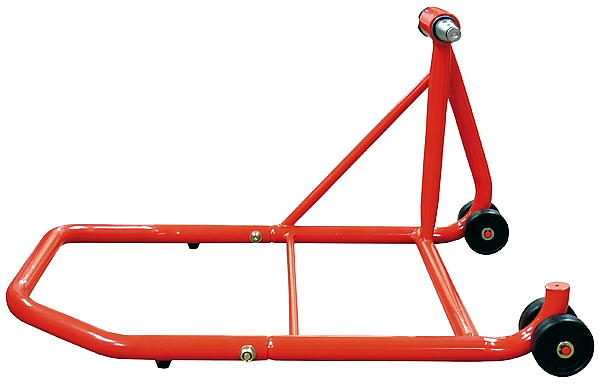
Tank Protection - Sides & Top
Radiator & Oil Cooler Protection
For my original RS, I purchased a 3rd party tank pad for the top/rear of
the tank to protect it from wear and tear because when sitting on the
seat, the front of my textiles were always near or against the tank. It
must be the matt black paint finish on the tank of the RS, for no matter
how I tried, the tank pad would become unstuck and curl up. I was ready
to use clear silicone sealer to finish the job but the RS went in for
it's service before I could get around to it.
For my original RS, I purchased TechSpec Snakeskins pertaining to the
2016 Triumph Speed R model (none available for the RS). These offered
side wear protection for the RS tank and extra grip for my knees,
Although they stuck instantly and stayed stuck, I was never happy with
their shape as they did not cover the entire sides of the tank. This
time around I have ordered the 'Generic Variant' of the TechSpec
Snakeskins, which are 2 x sheets 7.5" x 13" which I intend to cut to
shape from templates of the side of the tank (right and left) and as a
bonus, a tank pad for the top/rear of the tank is included.
I have fitted my generic TechSpec Snakeskins to my new RS and they stuck
well and stayed stuck. I used a sheet of cardboard to make a template
for the FULL sides of the tank and used sharp scissors to cut the
rubber. The sides and the top are now well covered and look great.
After a while, I got fed up with the Snakeskins Tank Pad as it did not
cover very much on the top of the tank. The RS has a neat wheelbase and
the higher seating position means (its an age thing) I am straddling the
tank when mounting the bike. I found that the front of my jacket was always up against the tank and
when mounting the RS, my jacket tended to drift on the tank paintwork
above the tank pad. I decided to replace it with a MotoGrafix Triple
Tank Pad. The old Snakeskins Tank Pad simply peeled off and I stuck it
firmly on the door of a metal cabinet in my garage. I cleaned the tank area
of the RS with mentholated spirits, heated the
tank paintwork with a hairdryer and popped on the new tank pad which
stuck fast and firm and so far has remained firmly stuck to the tank.
After I was out and about on my RS, I noticed that the front of the
radiator and oil cooler were heavily impregnated by dead flies and there
was a dirt trail up the middle of the oil cooler from the rear of the
front wheel. The RS was purchased for sports handling and invariably
would be ridden at or near to the 60mph speed limit on country roads. I
reckoned it would only be a matter of time before a stone would be flung
into the oil cooler or the radiator and I would be stranded miles from
home. Therefore, I have ordered up (black powder coated) aluminium
protector sheets for the RS radiator and oil cooler from Evotech-Performance.
These slip onto the front of the radiator and oil cooler using the
existing fixing bolts. Now fitted - see image below -
Oxford Indoor Cover
My RS motorcycle stands in a large agricultural metal framed garage and
although the roof is lined with condensation prevention panels there is
a fair amount of condensation and dust which adheres to the RS. During
the summer the condensation was non existent but as the weather cooled
with the onslaught of Autumn, I began to notice dampness creeping onto
the engine and frame of the bike. It was time for action and although my
RS was sprayed with rust repellant, I decided to purchase an Oxford
Protex indoor cover. It is ideal as the material is soft and designed to
repel dust and condensation.
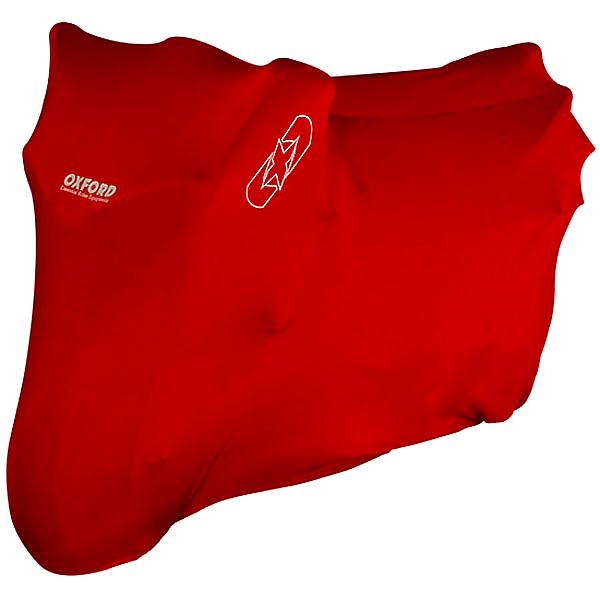
I went for the RED MEDIUM version which on later reflection was a
mistake. The medium size is 100% correct and the cover is a great fit
but red was the mistake. No matter how careful you are in putting a
cover on a bike; inevitably there will be oil or grease from the chain
and rear wheel area that will soak onto the material and boy does it
show up on red - I should have purchased the black version.
Chain Cleaning & Checking
I have covered the checking of the entire motorcycle and the chain tension in
the
Triumph Speed Triple RS Daily Checklist
which I use before taking the motorcycle out on a trip.
I have a Scottoiler Unit fitted on the RS that lubricates the chain but
the
chain and sprockets as well as the rear shock pick up a fair bit of
crud. When I see the muck building up, I take the bike out for a trip,
heat up the chain and after putting the RS on a rear stand, I treat the
chain, sprockets and rear shock with SDoc 100 Chain Cleaner Gel. I let
it settle in for about 10 minutes and then using a Bike It Chain Brush,
I can loosen the crud on all 4 sides of the chain. I finish off with
hosing the areas clean but I don't use a power hose. After a quick dry
of the chain using a blower or a floss free dry rag, I (sparingly) apply
S100 Chain Lubricant Oil to all 4 sides of the chain and rear
sprocket.
NOTE: I never run the RS engine to turn the chain, I use the rear
wheel (bike on a rear stand) and turn it clockwise with my right hand,
so that the chain moves away from the rear sprocket and cannot trap my
left hand which is applying the cleaner.
Check out the
S100 Website
for chain cleaner and lubricant.
After everything is cleaned and lubricated, I check the rear sprocket
for wear and tear on the teeth. Please watch the following video which
explains this procedure.
Check out this video for chain inspection, chain cleaning and
lubrication -
Caring for the Matte
Black Paint Finish
Main Menu
Enable the TSA (Shift Assist)
Set Indicators to
Auto Basic
Set Display Theme
to Theme1 and Style 02
I have created a few basic tables of the Main Menu/1st Sub Menus -
See Image of Right Controls Custer with HOME button
(little house icon) below -
The Joystick which is situated below the indicator switch on
the Left Controls Cluster is used to scroll
left/right through the Visible Tray's various display
choices and in certain displays, you can toggle it up/down
to open up more choices and by pressing the Joystick, you
can select a mode or start/stop a display. By pressing it in
for a few seconds, you can reset the display. The Joystick
is also used in conjunction with the M button on the Left
Controls Cluster to select Riding Mode choices, like RIDER,
RAIN, ROAD, SPORT and TRACK.
The RS matte black paint
is prone to streaking
and easily picks up finger marks, especially on
the tank paintwork.
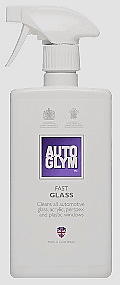 It must
not be washed or polished with conventional shampoos and waxes.
It must
not be washed or polished with conventional shampoos and waxes.
Up
close, matt and satin paints appear like miniaturised versions of the
Himalayas, with both mountains and valleys clearly visible – the source
of the paint’s flat, anti-reflective properties. Adding wax to either
has the effect of filling in said valleys, while over application of
polish can buff off the top of the ‘peaks,’ causing damage that’s all
but impossible to repair. Basically, avoid applying a too thick layer of
anything, and watch out for abrasives.
Because matte black paint (or satin paint) is easy to scratch but very hard to repair, it
is advisable that a power hose is used to remove the slightest trace of
grit or dirt on the paintwork before shampoo is applied and a final
waxing.
For lifting off the odd water streak or finger mark, I use
Autoglym Fast Glass which can be
purchased through Amazon.
For
a shampoo and wax (after power hosing off any grit or grime) I use
Autoglym Pure Shampoo
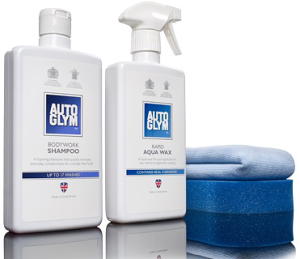 and Autoglym Aqua Wax which will not fill up the natural pits in the matte black paint
- so maintaining the natural look without a gloss finish. Both can be
purchased together as a kit from Amazon. After using the Pure Shampoo
and rinsing off with clean water, there is no need to remove the water
droplets, just apply Aqua Wax to finish off - see the videos below.
and Autoglym Aqua Wax which will not fill up the natural pits in the matte black paint
- so maintaining the natural look without a gloss finish. Both can be
purchased together as a kit from Amazon. After using the Pure Shampoo
and rinsing off with clean water, there is no need to remove the water
droplets, just apply Aqua Wax to finish off - see the videos below.
Clean sponges and micro
fibre cloths to use with the Autoglym products can be purchased from
Amazon. I always keep a clean sponge just for using on the tank.
Aqua Wax is liquid based and therefore safe to use on matte or satin paint
types (it follows the contours of the paint so won’t add gloss or
sheen), it also comes with a whole host of benefits primarily
associated with waxes, including UV protection and a degree of hydrophobicity, the latter making future cleaning all the simpler and
swifter.
Check out these videos regarding the Autoglym products -
TFT Screen + Main Menu
The TFT screen is brilliant and the choices of display 'blow the mind'
and they are all excellent.
I chose the Menu/Display (Theme 1 - Style 2) shown in the image below
and when out for ride and using the joystick on the Left Side Controls
Cluster, I can scroll across left/right/up/down through all of the
bottom screen Visible Tray displays - although I tend to leave it as
shown.
More on the Main Menu after the TFT Screen image below -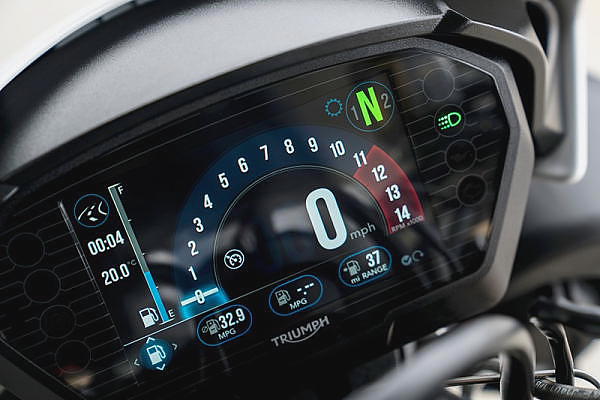
The Main Menu for full editing capabilities is accessed by pressing the
HOME button (little house icon) on the Right Hand Controls
Cluster. (see image after the table section below)
I have left all the Display Setting Choices in the Display Setup/Visible
Tray enabled
which is the default mode in the menu. NOTE: The
Visible Tray is shown on the bottom of the TFT Screen in the image
above.
My changes in the Main Menu are -
MAIN MENU
1st Sub Menu
Riding Modes
Rider
Bike Setup
Rain
Trip Setup
Road
Display Setup
Sport
Lap Timer
Track
Reset Defaults
Reset all to
Defaults
MAIN MENU
1st Sub
Menu
Riding Modes
Bike
Setup
TSA
(Shift Assist)
Trip Setup
Indicators
Display Setup
ABS
Lap Timer
TC
Reset Defaults
Service
MAIN MENU
1st Sub
Menu
Riding Modes
Bike Setup
Trip Setup
Display
Setup
Theme
Lap Timer
Visible
Tray
Reset Defaults
Too
many other headings to list
See Image of Joystick and M button on Left Controls Custer
below - 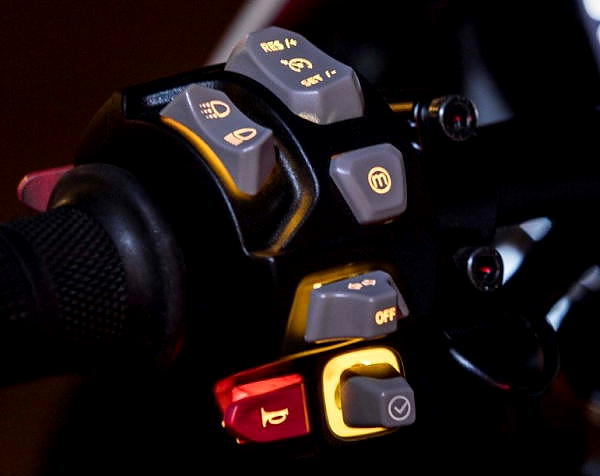
Controls
The Triumph Speed Triple RS controls are most excellent (once you find
out what they are) and I did not have any problem with
them. Not once did I operate the wrong control by mistake, not even the
indicator switch which sits above the joystick on the left control
cluster.
Starter Switch
The red starter switch on the RS (keyless ignition) is on the Right Controls
Cluster - see image below.
Normal Start in Neutral Gear
RS Smart Keyless Ignition Fob in your pocket (set to GREEN/ON)
If Triumph Alarm Fitted - Disarm using the Alarm Fob and start bike with 45 seconds or alarm immobiliser will activate
Press the top of the starter switch back and the RS logo appears in TFT Screen and then the display is shown
Press the bottom of the switch once and the ignition system engages, the TFT screen displays all the warning lights and at the same time the steering lock makes a short click/hiss as it unlocks
Make sure the bike's gear is in neutral
Hold front brake lever, hold in clutch lever - press the bottom of the starter switch and hold - the starter engages the engine to fire up the bike then release the hold on the starter switch
Let the RS idle for 30 seconds - Make sure the oil pressure light extinguishes immediately - If not - switch engine off. The oil pressure light is an oil can icon on the right of the TFT screen.
Hold front brake lever, if side stand down, flick up
Hold front brake lever, hold in clutch lever and select 1st gear - ready to move off
Quick Start in Neutral Gear (alarm switched off and the side stand up or down - RS key fob in your pocket) -
-
Hold in front brake lever and clutch lever - press the bottom of the starter switch and hold longer until the starter engages the engine to fire up the bike then release the hold on the switch - at the same time the steering lock unlocks but you cannot hear it for the starter motor
-
Quick Start is a faster method that Normal Start BUT the TFT screen remains black until the engine starts
-
When the TFT display comes on - make sure the oil pressure light (oil can icon) on the right of the TFT screen extinguishes along with the other warning lights
-
Hold front brake lever, if side stand down, flick up
-
Hold front brake lever, hold in clutch lever and select 1st gear - ready to move off
RS Stalled in any Gear
-
Hold in clutch lever - press the bottom of the switch and hold - the starter engages the engine to fire up the bike then release the hold on the switch - change gear if necessary and move off
Switching Off in Neutral Gear (in neutral the side stand can be up or down) -
-
Press the top of the switch completely back and the RS shuts down
-
Turn the steering to lock position and press the Lock Button at the back of the Right Controls Cluster and the steering lock makes a short hiss/click noise - check the steering is locked
-
Set Triumph Alarm by pressing the grey button on the alarm fob and indicators flash twice (if optional alarm fitted)
Horn
The
red horn button is situated front/bottom of the Left Controls Cluster
and when pressed there is a peep sound that is fairly loud but more
importantly it is sharp to the ears. Now this is ideal to warn women
drivers that you are approaching - their ears are conditioned to pick up
sharp sounds, even in their sleep - the sound of crying babies is an
example.
Indicators - Set for Auto Basic
I had the indicators on the Left Controls Cluster, set for Auto Basic and they switched off after
a short distance
but Auto Basic is not governed by the movement of the steering, it
is actually an 8 second time frame and an additional 65 metres of
travel. However, it is an unlimited time frame if the RS is standing
still, say at a busy junction and then they switch off after an additional 65 metres of travel. I
started to use them in Manual Mode as I found that when
entering long slips of the motorway in heavy, slow moving traffic, the
indicators switched off before I entered the slip. However, in manual
mode, it is easy to forget they are switched on, especially in heavy
city traffic where you can be distracted. So it is back to Auto Basic
and keeping an eye on them when entering dual carriageway or motorway
slips.
Cruise Control
The cruise control is awesome and it takes a fair bit of deceleration movement on the throttle
(acts like a switch)
before the cruise is disengaged. When running in cruise control, if you accelerate and then release the
throttle, it will return to your chosen cruise setting. To set the cruise
control on the Left Controls Cluster, flick and hold briefly the cruise
switch to SET and a green indicator on the left of the TFT screen will
appear/confirm that cruise is set. To decrease speed, press the cruise
switch set button, to increase speed, press the cruise switch resume
button.
Braking on either brake, disengages cruise and to resume cruise, press
the cruise switch resume button.
Lights
I left the bike set on daytime running lights with the green light
indicator showing on the right of the TFT screen. To select dip beam,
you move the light switch on the Left Controls Cluster down and then to
select high beam, you flick the red flick lever under the front of the
Left Controls Cluster. By toggle flicking the red flick lever you can
dip or high beam your lights. The day running lights look great and when
in day running mode, you can flick the red flick lever to flash your beam
light. For normal day use, I leave the lights in day running mode.
Mode M Button + Joystick + Home Button
The M Rider Modes button is situated on the
Left Controls Cluster
and takes you into the motorcycles Rider Mode Menu on the TFT Screen
bottom section, (Visible Tray) to select the various
modes, RAIN, ROAD, SPORT, TRACK and RIDER. Using the M button and
then the Joystick control with the bike coasting - throttle rolled off,
clutch lever in and NO brakes applied, you can select the desired riding
mode displayed. To edit individual riding modes, you use the HOME
button (button has image of a small house) on the Right Controls Cluster
and the Joystick control to toggle and press Joystick to select a
desired setting. See more in the TFT Screen + Main Menu Section above.
You can link to it from here .......click
here
Left Controls Cluster Images

Right Controls Cluster Images
Sports Motorcycle Comparisons
When compared to a sports motorcycle, the
Triumph Speed Triple RS may be faster around a corner than a
Honda Fireblade but in a straight line, watch the Fireblade disappear,
especially if you are both in 1st gear at the time.
The Fireblade does 100mph in 1st gear whilst the Speed Triple RS does
105mph in 3rd gear at 11,000 rpm.
So what the hell is a Triumph Speed
Triple RS - I reckon it was spawned to be a street motorcycle and
someone at Triumph let their imagination run riot and morphed it into a
track bike. So it is a 'full on' sports bike for handling with upright
bars and a gearbox leaning slightly towards street use BUT still
mental (when it wants to be) on country roads. Its what you want for
everyday use and/or the track, especially when you dislike the seating position on
a Fireblade, a BMW S1000RR or a Suzuki GSX-R1000. The RS is a motorcycle
that you can enjoy riding in the urban environment, take for a crazy
blast on country roads or cruise at 70mph along the motorway with cruise
control activated.
Build Quality
The build quality of the RS is superb and the motorcycle when moved
around in the garage feels solid and strangely chunky with its low centre of gravity. I can feel the weight but on the
road it feels lightweight and very easy to handle.
Maintenance & Warranty
The Triumph Speed Triple RS has a 2 Year Warranty and must be maintained
annually or at a maintenance interval in relation to the mileage,
whatever comes first. It is unlikely that I will ever maintain my RS in
my garage and instead it will go to the Triumph Dealer. However, I will
perform the basic maintenance checks of the RS, prior to taking her out
on the road. You can now read and download my
Triumph Speed Triple RS - Daily Checklist.
Checking the engine oil level is a critical procedure due to the
advanced way the oil is held in the RS and the nature of the oil flow as
it is pressurised around the oil channels. As per page 99 of the RS
User's Manual which is supplied with the bike, the engine oil level must be
undertaken with the RS in an upright position (not on the side stand) with both wheels on the
ground and the engine oil must be warm. Therefore it is best to check
the oil regularly, especially after a run out on the bike and before the
oil becomes cold. To obtain an accurate reading, the oil filler
plug/dipstick has to be fully screwed home before removing to perform
the oil check. The maximum level of oil is measured at the upper
marking, which is just above the dipstick area that is scored with cross
section cuts.
Checking the Pirelli Supercorsa SP tyres for cuts/abrasions/damage
is a checklist routine which is best undertaken on a regular basis,
before riding out. I find that the RS requires more than weekly regular
tyre pressure checks, (check prior to a ride out) and the correct tyre
pressure in relation to best handling performance is required. I have 3
tyre pressure gauges and each one delivers a different reading, One of
them is certified, so I tend to rely on its reading. The other two are
out by as much as 2 PSI below and 4 PSI above. The recommended tyre
readings, must be taken with the tyres COLD, and are front=34 PSI and
rear=42 PSI. Important information on the
Pirelli
Supercorsa SP Tyres.
Key Fob + Rear Seat
Security + Fuelling
The smart keyless ignition fob is rather large in the palm of your hand, especially if you
also have the optional alarm fob, but both are bearable. The actual key
for the petrol tank and the rear seat removal is retracted inside the
key fob.
The smart keyless ignition fob must be switched to
GREEN/ON using the Triumph logo button on the stainless steel side. Press it for a few seconds until the RED indicator turns GREEN/ON and vice versa to switch it RED/OFF. To check the fob setting, briefly press the Triumph logo button. I guess when not in use, the RED/OFF setting will preserve the battery? When the battery starts to fail, you can replace it with a CR2032 lithium battery by switching the fob to RED/OFF and then using a 1.5mm Allen Key to open up the fob. NOTE: From time to time, you can test the battery quality by placing the smart keyless ignition fob about 1 metre from the bike's transponder receiver which is situated near the centre of the RS inside the frame above the rear suspension unit. Once the distance is reduced for the fob to work, it is time to replace the battery.If the smart keyless ignition fob fails or is lost, you can use one of the spare keys for the RS to disable the bike's immoboliser and start it. You place the spare key's black plastic section against the lower centre of the transponder receiver, a large black unit which is situated in the centre of the bike (inside the frame) directly above the rear suspension unit and then switch the bike's red start on/off switch to ON. You should hear a little click as the keys transponder activates the system and the TFT display lights come on - you can then remove the key, switch on the ignition and start the bike. It is a bit of a fiddle to get the spare key inside the frame and against the lower centre of the transponder receiver unit so I held the key by the long metal end. Sometimes you have to circle the spare key around the centre of the transponder receiver unit until you hear the click and the TFT display lights come on. I also tried the smart keyless ignition fob (switched RED/OFF) in standard key form and the bike's transponder receiver unit did eventually recognise it, after about 10 attempts? I think it may have something to do with my padlock key and the alarm fob being attached to the smart keyless ignition fob? NOTE: If the RS is fitted with the Triumph alarm system you must disarm the alarm first and using the spare key get the RS started within 45 seconds before the alarm immobiliser kicks in.
When you first get the RS, test your spare keys to make sure they can individually start the bike and make sure if you have the master key ignition fob on you, switch it to RED/OFF first.
For everyday, normal use, the RS detects the smart keyless ignition fob in your pocket (fob must be switched to GREEN/ON) as you approach and allows you to engage the red start/ignition switch on the right control cluster to start the bike. At the same time, it allows you to lock/unlock the steering lock via a button on the right hand control cluster. My RS is fitted with an alarm so the back seat or the replacement cover for the back seat, have sensors built into them. If the seat or replacement cover is removed before the alarm is unset, the bike alarm will activate.
I did not have a problem filling the RS with petrol. The bike was light enough to hold upright as I sat on her, the petrol cap was easy to unlock and the petrol went in very easily. The petrol gauge proved fairly accurate and after a few seconds of moving away, it displayed the full setting on the gauge. A quick touch of the joystick resets my average mile display and my mile range - - - the actual mpg centre/bottom display always resets to -.-- when the RS is standing still (see image of TFT screen below).

Fuel Consumption - Replacement RS Motorcycle
Seating Position
Brakes & ABS
The first 100 miles
drove me up the wall but thereafter is was not half bad. At 500 miles, I
was looking forward to the 500 mile service and I actually put the RS
off the road in the garage until the pre-booked time at the
Triumph Dealership.
Warm up the engine then turn off the
ignition
Remove the oil drain plug and allow oil
to fully drain (with the bike on the side stand on level ground)
Remove the old oil filter
Refit the oil drain plug with a new
sealing washer (25Nm)
Fill the engine with oil (3.2 litres) - this
level does not reach the engine oil filter screw hole and does not
spill out over the engine
Apply a smear of clean oil to the
sealing ring of a new oil filter, then fit and tighten (10Nm) -
there is no requirement to fill the new oil filter with oil before
fitting
Check and adjust
oil level as necessary (Maximum is 3.8 litres)
Start the engine and let the engine
idle - DO NOT REV THE ENGINE - ensure that the oil pressure light goes out shortly after
starting
Allow the engine to idle
for 30 seconds - DO NOT REV THE ENGINE
Stop the engine - check and adjust oil
level as necessary
I have completed over
2,000 miles on my replacement Triumph Speed Triple RS and I am now
averaging 54.3 miles per gallon during city, motorway and a lot of country
road blasts. On motorway trips in constant 6th gear at 70mph with cruise control on, the RS
delivers around 79.4 miles per gallon and at around 60mph it delivers
around 90.7 miles per gallon.
The RS has a stock comfort seat which soaks up the ride on your rear for
around 60 miles or as you break yourself and the RS in to put 1,000
miles on the clock, you can achieve in excess of 100 miles without any
'numb bum'.
I have a 33" inside leg and yet the seat height is enough for me to
ride the bike without any movement restrictions or cramping and there
is plenty of room between the seat and the pegs. I do not feel
uncomfortable reaching the bars, they are slightly forward but I am seated in a semi-upright position without any wrist
strain.
Mirrors
I did not think that I would like bar end
mirrors but the 'stock' ones on my RS (set long ways horizontal) are
bitchin. The rear view is excellent, with the mirrors set without my arm
or shoulder getting in the close/long distance view and requiring a
'life saver' glance over the shoulder to take in the very, very, very
small blind spot. The mirrors handle vibration very well and even in the
higher rev bands, I am still able to clearly see the reflective view
behind me. Lane splitting is a breeze and the mirror height is ideal;
posing no difficulty in slipping between vehicles sporting all sorts of
mirror sizes and heights.
Weight Saving - New Oil Distribution System
The RS
has a new oil distribution system which along with refined combustion
chambers, some carbon fibre parts, a lighter battery and alternator,
reduces some of the weight of the previous Speed Triple. A new sump
holds the 3.8 litres of oil lower in the engine and the sump drain plug
is now positioned horizontal above the sump base and away from any
potential road grounding (speed bumps, etc). The oil-flow is re-routed through the
cylinder head which allows for the removal of external oil pipes. The RS
weighs in at 189kg (dry) and I found the lower centre of gravity greatly
enhanced the handling.
The ABS and Traction Control are set up in the
Continental Inertial Measurement Unit which provides the vehicle’s
current movement status to all requesting devices -
more on this in the Riding Mode Section further down the page.
I found the front brake was progressive (brake lever dial set to 19) and yet, when required, a
serious squeeze of the front brake lever brought the bike to an abrupt
halt. At setting 20 on the brake lever dial, I found the braking was too
abrupt. As the miles piled on and the pads wore in, the brakes became
even more efficient. The rear brake proved ideal (clutch/rear brake/throttle) for those
slow manoeuvres in slow city traffic and for lane splitting. It has some
bite when used on its own, for at slower speeds on bone dry roads and on the odd occasion, the ABS kicks in to
prevent lock up of the rear wheel. Out on the
country roads at higher speeds, it was comforting to know that the
brakes could slow down the bike, even if I overcooked a corner. I never
attempted an emergency stop using only the front brake but using the
front and back, the ABS did not kick in as fast (on bone dry roads) as
most other bikes I have ridden, which I enjoyed, especially as the wheels
did not lock/skid. I have not used the RS in wet conditions - this area
is now covered further down the page in the RAIN MODE section. For all the
default Riding Mode Configurations - RIDER, RAIN, ROAD, SPORT and
with the exception of TRACK, the default ABS settings are the
same, although the Traction Control varies.
Acceleration + Exhaust Note
Even when running the 1st RS in, I thoroughly enjoyed the experience. As I
neared the 500 mile mark, I could open her up to around 6,000 revs and
the acceleration was awesome, coupled with a glorious induction roar. I
have to admit, the acceleration up to 7,000 revs would be more than
enough but the RS has much more to offer (after 1,000 miles of use). I
never felt that I was having to hang on, even although the torque surge
was massive. As the miles pile on, the exhaust note gets louder.
Suspension Setup
I have not altered the factory default setting which I have found
excellent for road holding and handling. I weigh in at 15 stone and the
ride on the bike is firm. I guess, I could ease off the rear and make
the ride a little softer but then the handling may not be so good? For
now, I intend to leave the suspension settings alone.
Suspension + Handling
The suspension of the Triumph Speed Triple RS is everything you would
want in an Öhlins setup. Once I had her mileage up near the 500 mark, I
took her out on the Edinburgh to Moffat to Peebles road with the most
awesome twisty corners you could imagine. There were negative, positive
cambers, small humps, tight and sweeping corners with hump back bridges
and man she stuck to the road like glue. Make no mistake this is one
serious sports machine and even with a standard comfort seat you know
she had a hard suspension designed to handle any road condition or
corner thrown in her path. I never felt any 'numb bum' on the country
corners but it was different story on the motorway. I now wear 'cycle
gel pants' under my textile or jean trousers and they work. They say
that after about 1,000 miles, your rear end gets used to a sports bike,
so perhaps, eventually, the gel shorts can stay at home - I chucked them
when my 2nd RS reached around 1,200 miles. I cannot
complain, the RS is up there with the 'big boys' and even although she
is a 'naked' I reckon she can hold the corners with the best of the top
'full on' sports bikes. I over cooked a few corners and the cornering
ABS electronics smoothed out the ride but I admit, I don't like to rely
on such technology - nice to have it though.
City Riding - Throttle Control
I had no problems in city traffic and even with the bar end mirrors, I
could lane split with ease. Smooth, very smooth throttle control from
almost stop to moving forward, even down at sub 10mph speeds and
at almost dead stop,
coupled with clutch/rear braking, she is a breeze to
manoeuvre.
The only downside is that her 'full lock' turning circle is not the best
by bearable. Coming towards a roundabout at sub 20mph for immediate
entry without stopping, she will continue without a
stutter - in the correct gear of course. I have a 33" inside leg and I
found that when required, I could easily reach the road and 'duck walk'
the bike back into a parking space although I did fit a rear 'pillion
grab handle' which makes moving the bike about with the left bar and the
grab handle, a lot easier - I am not a fan of moving a bike using only the
bars. The RS has a hard suspension but small potholes and rough tar
repairs were smoothed out relatively well but you could still feel them.
However, I never suffered from any 'bottom end' pile drivers, which was
nice.
Motorway Riding
Cruising along at 70mph with the cruise control switched on, is a great
feeling. Both hands on the bars but relaxed in the knowledge that the
throttle will not easily disengage the cruise at the slightest touch, it
takes a deliberate de-acceleration movement on the throttle (like
throwing a switch) to disengage cruise or a slight touch on either
brake. You come up on a slow car in the inside lane, open up the
throttle to accelerate past and then relax as the throttle re-adjusts
automatically back to your cruise control pre-set speed. You are
travelling at 50mph and in a blur you are at 85mph (the 500 mile running
in top limit) as you open up the throttle in 6th gear - oops and you let
her immediately roll back to the pre-set cruise control speed limit. I
never found the wind to be a problem, the bike felt stable enough and
even with cross winds she never wavered from the straight line. I have
not used the RS in the rain so I cannot comment (as yet) on that
experience. My RS is fitted with a small smoke screen which is beautiful
and finishes the 'eye candy' of the bike. It seems to work as I don't
seem to suffer from any oncoming wind blast, even on the odd occasion
where passing a vehicle has taken me to the 85mph mark (for a moment)
but I cannot comment on what the RS would be like without the screen.
Country Roads + Modes
The RS is built for the twisty country roads
and there is nothing like leaning her over and coming out of the corner
as you open up the throttle. Man what a feeling and the roar of the
induction noise adds to the experience. I love approaching a tight
corner, clutch lever in and manually blipping the throttle on the
downshifts; down through a couple of gears in a millisecond (without any
clunks) and holding the line as I then throttle her, coming out of the
corner. I have only used the RS on bone
dry roads and judging by the small amount of tread on those Pirelli Supercorsa SP tyres, I will be switching to RAIN mode in the wet. I have not tried
SPORT or TRACK mode as yet, due to limiting the revs as I run her into
the 500 mile marker for her first service. For the moment it has been
ROAD mode and that is enough, believe me, that is enough.
Running In
I have been out and about on the motorcycle and running up the mileage
for its 500 mile service and then it will be onto 1,000 miles before I
can finally open her up.
The rev indicator is setup to display an orange section when the bike
reaches the running in rev limit of 3,500 revs and at 100 miles the
orange section moved on to the next rev section of 5,000 revs and so on
as the miles piled up.
The chart of my
running in (restricted) revs
at 6th gear speeds, is as follows -
Mileage
Gear
Revs
Speed
0 -100 miles
6th
3,500
56mph
100 - 300 miles
6th
5,000
75mph
300 - 600 miles
6th
6,000
85mph
600 - 800 miles
6th
7,000
?
800 - 1,000 miles
6th
8,000
?
1,000 miles PLUS
6th
11,000
?
500 Mile Service - Oil Change Problem
I took my 1st RS in for its 500 mile
service on the 25th May. After the Triumph Dealer serviced it and
started it up, the oil pressure light stayed on. The sump was removed and the engine checked but the problem
remains - now Triumph are directly involved to try and resolve the
problem. The RS boasts a new style of oil system. I have to laugh at
fate - I purchased the RS because I did not think my first choice (the Aprilia Tuono
1100 Factory) would prove reliable.
Motorcycle
Rejected (30 Day Clause Invoked)
I did invoke the 30 day clause and the Triumph Dealer offered me a
new bike or a full refund. I opted for a brand new Triumph Speed
Triple RS replacement, which I should receive within a few weeks.
The fault remains unresolved on my original RS and they have
promised to inform me of the result - The Triumph Speed Triple RS
was too good a motorcycle to pass on.
500 Mile Service - Oil Change Problem Resolved
(5th June 2018)
Triumph
have established that the cause was a vacuum created in the oil
distribution system which blocked the oil flow. This can occur when the
new oil is being filled in the engine. There is now a correct
procedure to follow when changing the oil and filter - done in a specific
order to prevent the vacuum occurring. Please Note: This is now
an alternative procedure to the one outlined on Page 101 of the RS
User's manual which is supplied with the motorcycle.
I received a courtesy phone call (8th August) from the Triumph
Dealership regarding my experience with my 2nd RS and I raised the
methodology for the oil and filter change. The Technical Director
confirmed that he had first received this during a phone discussion with
Triumph in early June and also in the latest Triumph Bulletin which also
covered other issues. He outlined the procedure in brief but as I intend
to use the Triumph Dealership to service my RS, I did not delve into it
any further.
Today, (17th August 2018) the Triumph Dealership Technical Director sent
me an email outlining the full oil change procedure as outlined below.
-
The Maintenance Page 101 of the RS User's manual now requires correction - the new oil is filled in the engine AND THEN the new oil filter is fitted and not the opposite way around as per the current 2018 manual.
-
As per Page 101 of the User's manual, the engine when started should be allowed to idle for 30 seconds to allow the engine oil to circulate, before revving the engine.
-
To expand on Page 101 - as per the Maintenance Page 99 of the User's manual - the engine oil must be at full operating temperature with the RS standing upright and off it's stand with the dipstick screwed fully home in it's seat before removing it to perform the oil check. The maximum level of oil is measured at the upper marking, which is just above the dipstick area that is scored with cross section cuts.
-
The Maintenance Page 99 of the User's manual regarding the oil check procedure is also linked from Daily Safety Checks - Page 75.
This vacuum issue is 'random' and I was unfortunate that it happened to my RS. I now appreciate that after the warranty period, some bikers will want to change the oil and filter themselves - I hope the above information is helpful?
Replacement Motorcycle - 2018
Triumph Speed Triple RS
-
>>> Now Fully Run In <<<
First of all, let me state that the incident I experienced with the 500
Mile Oil Change did not in anyway dissuade me from accepting a 2nd brand
new RS rather than a full refund from the Triumph Dealer.
I could have easily taken the money and purchased a BMW S1000R or the
Aprilia 1100 Factory Tuono. However, I had spent a great deal of
research on the RS prior to my original purchase and after the demo ride
- it was a no brainer, the RS ticked all the boxes. Shit happens and
many new models experience wrinkles - I knew that before I purchased the
RS, one of the first to do
so BUT
at my age as I hit 70 years old, I opted to purchase the RS before time runs out.
I
have taken delivery of my replacement RS (23rd June 2018) and have already
put 150 miles on the clock - sticking to ROAD mode. The quick shifter is
fitted and electronically calibrated but not enabled in the bike's menu
settings. I will not be using it until the RS has covered some miles
and I can raise the revs. It is booked in for its service in 4 weeks
time but I reckon I will have achieved 500 miles long before then - the
RS is such a blast to ride. I completed the 500 mile running in mileage
in 4 days and the RS is now sitting in my garage waiting for its 500
mile service appointment in the middle of July. The 500 mile service
went without a hitch and I am back on the road racking up the miles. By
the 19th July, I had clocked up 1,026 miles.
Rear End 'Numb
Bum'
Now that I have reached 1,000 miles on the bike's clock, I have chucked
the pedal cycle 'gel pants' as I can easily ride the RS for around 60 miles before I
have to take a break. In fact the other day, I did a 124 miles round
trip without a break and only a slight 'numb bum' which was easy to
shake off. I felt it on the motorway but by raising my rear of the seat
and placing my weight onto my legs, knees and the pegs for a few
moments, I shifted the pain and I was good to go for another 5 miles
before I had to repeat the exercise. There is no doubt that as the miles
pile on, the pain piles off - its like riding a horse and breaking in a
new saddle.
Clunky Gear Box
I find the Triumph Speed Triple RS gearbox a
little bit clunky - which simply means that using the clutch,
there is an inconsistent gear change clunk as opposed to a nice click, from 1st through 2nd to 3rd on the upshifts
and likewise from 4th down to 3rd, down to 2nd and down to 1st. This was
also the case with the Demo RS (no quick shifter), my 1st RS (no quick
shifter) and now the replacement one with a quick shifter fitted but
using the clutch. Interestingly, when my RS is first started and the
engine oil is relatively cool, there are no clunks in the lower gear
changes when using the clutch. I
am hoping that as the miles pile on and the gearbox wears in - it
becomes slicker in the clicks rather than the clunks.
Note: Using the
clutch disables the quick shifter.
IMPORTANT
NOTE:
This section refers to using the gearbox without a quick
shifter fitted.
To
mitigate gear change clunks, you can use the clutch and ease the shift
up from 1st to 2nd gear at around 18-20mph. To clutchless upshift with
gradual or fast acceleration from 1st gear through each gear to 6th you
can place foot pressure under the gear lever, then in a
millisecond/miniscule action, roll off the throttle to release the drive
on the gear train, the next gear up then slips into place without a
clunk and in that millisecond the throttle is reapplied.
The 1st section (0 - 1.42) of this video explains clutchless upshifting -
I
use the clutch to downshift from 6th through each gear to 1st - it is foot pressure on the gear
lever, then in a millisecond/miniscule action it is clutch with a blip
of the throttle to raise the revs and the gear lever downshifts to the
next gear and the clutch is released - either to open up the throttle
for faster acceleration or to roll off the throttle to decelerate the
motorcycle. At sub 15mph as the RS slows for a junction or traffic
lights, you can use the clutch to ease the RS from 2nd gear into 1st
gear without a throttle blip and there is no clunk.
NOTE: When stationary and with the clutch lever held in and
engaging 1st gear from neutral, there is always a heavy CLUNK from the
gearbox - my RS idles at 1,400 revs.
I have read of some RS owners experiencing incidents of where the RS will not engage neutral when stopping and on the
shift to neutral, jumps from 1st to 2nd or 2nd to 1st and back again.
Sometimes you have to drive the bike slowly forward a bit in 1st and
then try again. This appears to be caused by a poorly adjusted clutch
cable. From experience, clutch adjustment is best left to a Triumph
dealer when the RS is being serviced.
RIDING MODES
I don't intend to fiddle about with the mode settings other than
selecting the normal default modes (using the M button on the Left
Controls Cluster and then the Joystick to toggle/select) to suit the road conditions or the
level of entertainment at my disposal - for example selecting ROAD
mode for everyday riding or RAIN mode for wet road conditions or
SPORT mode for a little bit more fun. I doubt that I will ever be
in TRACK mode but you never know?

Continental Inertial Measurement Unit
The Triumph Speed Triple RS is fitted with a
Continental Inertial Measurement Unit which provides the vehicle’s current movement status
to all requesting devices. The verified signals of yaw, pitch and roll
rate and longitudinal, lateral and vertical acceleration are transmitted
to the data bus via standardised interface. The signals are used in
complex control algorithms to enhance comfort and safety applications
for passenger and commercial vehicles (e.g. ESC, ADAS, AD) as well as
for motorcycles (optimised curve ABS), industry and agricultural
vehicles.
The
Continental Inertial Measurement Unit
algorithms are matched to perceived road conditions and are given
corresponding names. The optimum algorithms are set in DEFAULT mode in
the RS menu and can be tailored/changed to suit the riders style. In
this respect the menu of the RS offers RAIN, ROAD, SPORT, TRACK and a
RIDER mode.
Below is the DEFAULT settings table for the Modes -
| Table | |
|
0 |
Default |
| 0 | Selectable |
| Not Selectable |
|
RIDER |
RAIN | ROAD | SPORT | TRACK | |
| ABS | (Anti-lock | Braking | System) | ||
| Road | 0 | 0 | 0 | 0 | 0 |
| Track | 0 | 0 | |||
| Off | 0 | Via Menu | Via Menu | Via Menu | 0 |
| MAP | (Throttle | Response) | |||
| Rain | 0 | 0 | 0 | 0 | |
| Road | 0 | 0 | 0 | 0 | 0 |
| Sport | 0 | 0 | 0 | 0 | |
| TC | (Traction | Control) | |||
| Rain | 0 | 0 | 0 | 0 | |
| Road | 0 | 0 | 0 | 0 | 0 |
| Sport | 0 | 0 | 0 | 0 | |
| Track | 0 | 0 | |||
| OFF | 0 | Via Menu | Via Menu | Via Menu | 0 |
Triumph Quick Shifter/Blipper - 21st August 2018
My quick shifter was first enabled after the 500 mile service (12th July
2018) on my 2nd Triumph Speed Triple RS and thereafter I had problems as
it proved inconsistent and very
often clunky in the
gear downshifts under 7,000 rpm. It worked perfectly well in the 7,000 PLUS rpm
range, especially when the RS was set in SPORT mode. I established from the Triumph Dealership (17th August 2018) that this particular
model of the Triumph
Assist Quick Shifter cannot be adjusted, other than the mechanical
fitting. I have attached a .pdf file which now covers this -
Triumph Assist Installation.
When correctly fitted, (according to the installation .pdf file) the
Triumph Assist Quick Shifter will not operate below 2,500rpm. It also requires a positive force
placed up or down on the gear lever for it to change a gear correctly.
Another strange peculiarity of having the quick shifter fitted OR
it may be because the RS has now more miles on the clock - is that in
the higher rev range, even at 70mph in 6th gear on the motorway, I do
feel a buzz through the bars and in the pegs, which I rather like.
20th August - Quick Shifter Re-Calibration: I decided to
check out the Triumph Assist Quick Shifter for myself so I measured the
connecting rod for the correct length and the quick shifter appeared
mechanically okay. Next, I disabled the quick shifter in the RS TFT
screen menu and rode the bike for about 10 miles. Thereafter on a quiet
road, I set the RS to ROAD mode, enabled the quick shifter in the menu and rode the RS in each
gear for around 10-15 seconds at around 3,500 rpm and upshifted using
the quick shifter between each gear. Now the quick shifter in RAIN, ROAD
and SPORT modes operates at
3,000 rpm and above for clutchless gear upshifts with either slight or fast acceleration on
a throttle held steady and for downshifts at 4,000 rpm and above
where there is reasonable deceleration with a throttle roll off and the
downshifts are even more proficient when the front brake is also
slightly applied. It even works from 1st gear on the upshifts and from
2nd to 1st gear on the
downshifts. I still have the buzz through the bars and the pegs
in the higher rev range, even at 70mph in 6th gear on the motorway.
If
you wish to read about a state of the art quick shifter, check this out -
HM Quickshifter
GP
SPORT MODE
In SPORT mode, the throttle is much more responsive and the quick
shifter operates best, up and down at 4,500 revs PLUS (tested on a
private road) and the
higher the rpm, the better the quick shifter works.
TRACK MODE
I cannot see myself using the TRACK mode for riding the RS on normal UK
roads.
On the track you
have the ability to run off, slide onto gravel or grass but on the road
you have walls, trees and the worse of all obstacles - the kerb stones.
I don't see myself as a road racer, so TRACK mode will not be used
unless I undertake a track training course and pay Knockhill Racing
Circuit a visit for a track day?
RAIN MODE
At last it rained and I was able to take the RS out for a spin in RAIN
mode where the
Continental Inertial Measurement Unit
drops the power output to 100 horses, slows down the throttle response
and boosts up the traction control for the wet conditions. The ABS
remains the same as in ROAD mode. There is a definite calming down of
the bike and likewise when it is raining, I calm down as well. So, I am
afraid there are no high speed cornering reports, no incidents of harsh
acceleration - I learned my lesson several years ago on a Scout when it
barrelled away from me on wet cobbles, when I gave it too much throttle.
For the ride it was very much upright on those almost slick tyres,
carefully treading around the grease covered roadway on the roundabouts,
and after the long dry spell, sticking very much to below the speed
limits. Now that I have been caught in torrential rain a few times, I
will be investigating an alternative tyre for when the current SPs are
due to be changed. I want a tyre with the awesome grip of the Pirelli
Diablo Supercorsa SP in the dry but offering better grip in very wet
conditions. This is now covered in the
Pirelli
Diablo Supercorsa SP Section
RIDING MODE CONCLUSIONS -
21st August 2018 - 1,635 Miles
With my Triumph quick shifter enabled in the menu and re-calibrated - I use ROAD mode for
urban and normal everyday use and select SPORT mode for short country
road blasts; barring rain or damp roads, which would necessitate a
switch to RAIN mode. I will not be using TRACK mode on public roads.
Triumph Quick Shifter Limitations: Due to the rpm operating range
of my Triumph Assist Quick Shifter, especially on the downshifts where
it is efficient and consistent at 4,000 rpm or above - it is inevitable
that when adhering to the speed limits on public roads, I am forced to
use clutch/throttle blips on the downshift to mitigate gear clunks.
Street Gear Upshifts: In RAIN, ROAD and SPORT modes during normal
street use, I use the clutch to slip the RS from 1st gear into 2nd gear
at around 18-20mph to mitigate the odd gear clunk. The clutch use
disables the quick shifter. I usually just use the clutch to gear
upshift at low revs but where roads, the speed limit and traffic permit,
at from around 3,000 rpm or above, I can clutchless upshift
using the quick shifter from 1st
through each gear to 6th gear, during moderate or fast
acceleration with the throttle held steady at the time of the upshift.
Flat Out Gear Upshifts:
In
ROAD and SPORT modes and from a standing start with flat
out acceleration, the RS in 1st gear will take me to 60 miles per hour
and
using the quickshifter at the rev limits, through to 2nd gear and above
to 6th gear. The upshifts are fast, slick and without any pause.
Gear Downshifts at Higher Revs: -
In RAIN, ROAD and SPORT modes,
I use the quick shifter at 4,000 rpm or above to downshift through the
gears from 6th
through each gear
to 1st and I find that it operates best with positive deceleration and
even better if the front brake is progressively applied - it produces a
nice rev blip and is often accompanied by an exhaust burble (nice).
However, I have found that when suddenly approaching tight corners, I
can downshift faster through several gears, by using the clutch and
throttle blips.
Gear Downshifts at Slower Revs: At slower speeds, I
prefer to blip up the
engine revs, using
the clutch/throttle on each gear downshift.
The clutch use disables the quick shifter.
I can also blip up the engine revs to clutch change from 2nd to 1st gear
without any clunking. I can also downshift using the clutch (without a
throttle blip) from 2nd to 1st in slow traffic conditions without any
clunking and slip into 1st gear at around 15mph.
NOTE: When stationary and with the clutch lever held in and
engaging 1st gear from neutral, there is always a heavy CLUNK from the
gearbox
- my RS idles at 1,400 revs.
Triumph RS Performance
The 1050cc triple engine delivers 150PS and a peak torque of 117Nm
at 7,150 revs. It's fitted with a new free flowing exhaust system with
twin stainless steel Arrow cans, an upgraded gearbox and with a graded
slipper clutch and 3kg weight saving - the RS is a substantial
improvement over the old Speed Triple.
The torque from the RS has no lull in its delivery during the
continuous and huge surge in acceleration - and that is in ROAD mode.
SPORT mode makes the throttle more responsive and there is less traction
control but to be honest, I never at any time felt the traction control
kick in and I spanked the RS on the corners.
The RS is the nearest you will get to riding a race
horse - you can feel the motorcycle flex as its frame blends itself to
the road and cornering conditions. I enjoy the upright/slightly forward
seating position on the comfort seat and the feel of a buzz through the
bars and pegs at higher revs and you can feel the massive torque that
starts at 1mph and never ends as it's massive engine power takes you
rocketing forward. It's handling on dry roads is awesome, especially when
cornering and although the RS weighs in at slightly over 200kg (wet) it feels lightweight on the road. You don't
have to break the speed limit to enjoy the RS as it sticks like glue and
takes you over
negative and positive cambers, small humps, tight and sweeping corners
with hump back bridges at speeds below or on the 60mph speed limit and yet
faster than any car or most other motorcycles could achieve - and in
safety. Even with it's stock comfort seat,
the suspension in default factory settings is relatively hard and you
will feel the road through the bars, even running over a very, very,
very small stone. This is good, its just what you want in a sports
motorcycle - to feel the road.
Consider this - in ROAD mode when you open the throttle wide in 2nd gear
at 20mph the RS
takes off like a bat out of hell and in seconds the engine has wound up
to 11,000 revs and doing 85mph before you then click it into 3rd gear and
before you have time to think, the RS is at 11,000 revs at 105mph and
then you run out of road. This is all on a private road (of course) and the front wheel gently lifts a few
inches of the ground for a set distance before it gently drops back onto
the tar again. I should have tried it with the faster throttle response
in SPORT mode, with less traction control interruptions - next time!
For road use, the RS is way overkill but great fun. On that private road in ROAD mode, it
delivered the following results -
| Gear | Revs | Speed |
| 1st | 7,000 | 40mph |
| 2nd | 7,000 | 58mph |
| 3rd | 7,000 | 72mph |
| 4th | 7,000 | 85mph |
| 1st | 11,000 | 60mph |
| 2nd | 11,000 | 85mph |
| 3rd | 11,000 | 105mph |
| 4th | 8,000 | 95mph |
I
would need to go on a race track to take the RS further up the gears in top
end revs. From the rev and speed examples, you can quickly deduce that
the RS is very unlikely to reach it's full potential on normal roads,
especially country roads in the UK where the speed limit is 60mph but
then the acceleration and handling, more than makes up for it.
In ROAD mode, in the city where the speed limits
are 20mph/30mph/40mph - the
speed
to matching minimum rev to a gear (without tugging the
engine) was as per the following table.
Note: Using the
clutch/throttle/rear brake, you can ride the bike at 2mph in 1st gear
for slow manoeuvres.
|
Gear |
Speed |
Revs |
|
1st |
8mph |
1,400 (idle revs) |
|
2nd |
18mph |
2,400 |
|
3rd |
30mph |
3,000 |
|
4th |
40mph |
3,200 |
| 5th | 40mph | 2,900 |
| 6th | 40mph | 2,200 |
In ROAD mode, on country roads where the speed limit is 60mph and 70mph on the dual carriageways and motorways, I have put in the speed and matching revs for 5th and 6th gears in the 50mph - 85mph speed range -
|
Gear |
Speed |
Revs |
| 5th | 50mph | 3,500 |
| 6th | 60mph | 3,900 |
| 6th | 75mph | 5,000 |
| 6th | 85mph | 6,000 |
Pirelli Supercorsa SP
Tyres & Alternative Choice
The factory fitted
Pirelli Diablo Supercorsa SP tyres are inflated - Cold
Rear=42 PSI Cold Front=34 PSI.
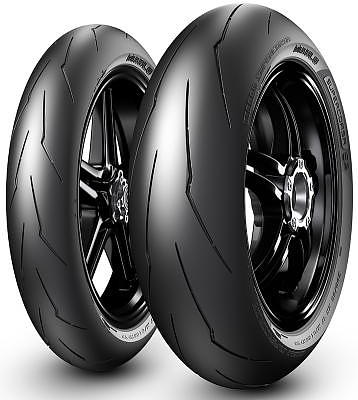
The Pirelli Diablo Supercorsa SP tyres are awesome on dry roads. They
stick to the road like glue and the handling and braking stability is
simply phenomenal. The tyre has an 'Achilles Heel' in that it does not
offer tremendous grip in the wet, especially in torrential rain on
Scotland's dual carriageways which are often prone to lying water. Its
not surprising, considering just how slick the tyres are - check out the
image on the right.
June 2019 -
As of 17th June 2019, and my RS having done 2,504 miles, and using a tyre
depth gauge, there is some decent tyre
tread
left
and the warning ridges inside the tread are still some distance from the
top. The front tyre depth is 2.5mm near the centre of the tyre and 2mm
nearer the edges. The rear tyre depth is 4mm near the centre of the tyre
and 3mm nearer the edges.
According to the Triumph RS User Manual, my tyres are on the depth
margin for travelling at around 80mph (minimum front 2mm 0.08inches,
minimum rear 3mm 0.012inches). It does not stipulate the road conditions
but I am guessing they mean on wet roads. The cornering grip of my RS in
the dry remains awesome, but I keep
the speed 'way down' in very wet conditions, especially on roundabouts
and when cornering.
I made enquiries with Pirelli as to an alternative tyre for my RS and
they recommended the Pirelli Diablo Rosso Corsa II as
the choice for improved grip in wet conditions and yet maintaining
outstanding performance in terms of cornering and quicker on the warm up
level required.
July 2020 - Alternative Tyre Choice: I have not done a great deal of miles on the RS since new, just 3,145
overall, due to the 2020 Covid-19 virus lockdown restrictions in
Scotland, which are much harsher than the rest of the UK and are still
being applied. Lockdown began in March, so long trips down the 'Borders
Region' with its grand twisty country roads, were out of the question. Although my tyres probably had about 500 miles left on
them, during my last trip I managed to puncture the back tyre when
passing some road works, so a new set of tyres are now called for.
In Scotland you are invariably going to get caught out in
torrential rain on the way home and these days, it is becoming more
common. Sunshine in the morning, rain in the afternoon. I have booked a
2nd year service for my RS, planned for the 23rd
July 2020 and I have ordered a set of
Pirelli Diablo Rosso III tyres which
were developed within the World Superbike Championship. There is more tread for the wet, but according to the reviews,
they
still offer -
-
A very quick warm up time, even in cold weather
-
An excellent compound balance between front and rear tyres for improved handling in the dry and the wet
-
Excellent grip feedback, especially on the front tyre with great stability
-
Large contact area for excellent grip/stability on the lean angles in corners
-
Greater flexibility in the sidewall for optimum acceleration out of corners
-
No squirming of the front or rear under heavy front braking or harsh acceleration
-
Excellent grip in torrential rain
-
Consistent performance throughout the life cycle of the tyre
-
Increased mileage and even wear
They are not the optimum tyre choice for dry track days
but I will not be on the track and I will not be pushing the Pirelli Diablo Rosso III
tyres
to their limit on dry country roads, especially the lean angle, when
cornering.
I picked up my RS on the 24th July
2020 from Edinburgh
Triumph and I was well pleased. The recall work was done, new brake
fluid, new software and all the usual 2nd year service work, including
oil, filter, clutch adjustment, etc; and my RS was shod with its new Rosso III tyres. I decided to immediately run in the new tyres and the
new front brake pads, so I took her out for a 'canny' 100 mile plus trip
on the motorway and country roads. Over the next few days and once the
Pirelli Diablo Rosso III tyres were fully bedded in, I let the RS loose
on the dry country roads. The grip, handling and feedback was awesome and every
bit as glorious as my previous factory fitted Pirelli Supercorsa SP
tyres. When I arrived home at my garage, I felt the tyres and I was very
impressed by their stickiness on my fingers. I still have to test them
out in the wet but if anything, with the extra tread over the Supercorsa
SPs, they will have more grip.
This review
summary relates to two Triumph Speed Triple RS motorcycles. My first
one purchased on the 5th May 2018 developed an oil flow pressure problem during its 500 mile service due to its oil
change. This was not the fault of the Triumph Dealer, it was a wrinkle
in the oil system which caused a vacuum and was later resolved by
Triumph. I rejected the RS and within a few weeks, on the 23rd June
2018, I received a second brand
new RS which has now covered in excess of 3,000 miles. Throughout the
entire experience, I cannot fault the Dealer Salesman and the Technical
Director who treated me with the
utmost respect and went out of their way to ensure a smooth transition
to my second motorcycle.
9th January 2022 - Triumph RS in the
Garage
Image of the Pirelli Diablo Rosso III tyres
-
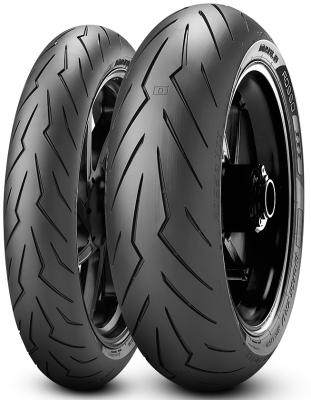
28th June 2021 - I went out on the RS during a dry morning and
after a few miles, the heavens opened and I was drenched by torrential
rain. To make matters worse, I was on the Edinburgh Bypass at the time,
travelling at around 70 mph. The rain was so heavy my summer gear was
soaked through within minutes and I was sitting cold and wet on the
bike. The tyre grip was excellent and the new Rosso Diablo III tyres did their job in clearing the
water. The only downsides, my backside was soaking and the rear seat of
the RS and the Arrow exhausts were caked in muck of the road.
NOTE: Pirelli have now released the new
Pirelli Diablo Rosso IV Tyres.
Review Summary
First of all, let me state that the incident I experienced with the 500
Mile Oil Change did not in anyway dissuade me from accepting a 2nd brand
new RS rather than a full refund from the Triumph Dealer.
I could have easily taken the money and purchased a BMW S1000R or the Aprilia 1100 Factory Tuono. However, I had spent a great deal of
research on the RS prior to my original purchase and after the demo ride
- it was a no brainer, the RS ticked all the boxes. Shit happens and
many new models experience wrinkles - I knew that before I purchased the
RS, one of the first to do so BUT at my age as I hit 70 years old, I am counting down
the years, so I opted to purchase the RS before time runs out.
Whether it is my RS or the
BMW S1000R or the Aprilia 1100 Factory Tuono, the stark reality is that
none of those motorcycles will ever reach their full potential on
a public road, unless you want to lose your licence or eventually hit a
kerb, an oncoming vehicle or a tree. In fact for most of the time the RS will be running at
somewhere around 4,000 to 5,000 revs with the odd 7,000 PLUS revs reached in
the lower gears when accelerating past a vehicle, especially when you
consider that at 11,000 revs in 2nd gear you are at 85mph. The
Pirelli Supercorsa SP
tyres lean towards the slick side so I expect perhaps 3,000 miles out of
them (on country road blasts) and it is RAIN mode in the RS menu for wet
conditions.
During a country road blast, you can feel the motorcycle flex as its frame blends itself to
the road and cornering conditions. I enjoy the upright/slightly forward
seating position on the comfort seat and the feel of a buzz through the
bars and pegs at higher revs and you can feel the massive torque that
starts at 1mph and never ends as it's massive engine power takes you
forward. It's handling on dry roads is awesome, especially when
cornering and although the RS weighs in at slightly over 200kg (wet) it feels lightweight on the road. You don't
have to break the speed limit to enjoy the RS as it sticks like glue and
takes you over
negative and positive cambers, small humps, tight and sweeping corners
with hump back bridges at speeds below or on the 60mph speed limit and yet
faster than any car or most other motorcycles could achieve - and in
safety.
Even with it's stock comfort seat,
the suspension in default factory settings is relatively hard and you
will feel the road through the bars, even running over a very, very,
very small stone. This is good, its just what you want in a sports
motorcycle - to feel the road.
Do I require a Triumph Assist Quick Shifter/Blipper for every day use
and for country road blasts - NO. Read more on the Triumph Assist
Quick Shifter in the main review.
The RS gearbox is slick but can be clunky on the upshift from 1st through 2nd to 3rd gear and on the
downshift from 4th down through 3rd to 2nd to 1st gear. To mitigate gear
change clunks - you can clutchless/throttle upshift and clutch/throttle blip up
the revs on the downshift. NOTE: These methods of operation can
be undertaken, with or without a quick shifter. Read more in the Clunky
Gearbox and Riding Mode Conclusions sections in the main review.
I normally ride my Suzuki GSX-1250FA Sports/Tourer (a Suzuki Bandit with
a fairing) on the Edinburgh/Moffat road, up through St Mary's Loch, over
to Selkirk and onto St Boswells and finally on the A68 back to
Edinburgh. Invariably, I would run that 'Borders' trip a couple of times
a year in the summer stopping off in Moffat for lunch but compared to
the Triumph Speed Triple RS, my Suzuki which is an awesome motorcycle,
now feels ancient. On the RS, I have made that trip 7 times (so far)
this summer and every time, I have a huge smile on my face.
The adrenalin factor is very high on those twisty corners, the
exhilaration you get, heightens your senses and brings with it an
awareness that you are more alive!
I have an optional fly screen fitted on my RS and at motorway speed
limits, I never feel any serious wind blast on my chest and the RS in
crosswinds is very steady and keeps straight. I weigh in at 15 stone and with the RS suspension set at factory
default, the handling is crisp. I can ride around 120 miles before 'numb
bum' creeps in but in any case, I normally stop at 50-60 miles for a
break.
I tested
the RS on a private
road and in 3rd gear at 11,000 revs at 105mph the RS remained straight,
stable and I did not feel the oncoming wind was interrupting my comfort
or control of the bike. I would like to try her out on a track and it
may still happen but next year, once I have got to grips with the RS.
I had no problems in city traffic and even with the bar end mirrors, I
could lane split in the dual carriageways with ease. Smooth, very smooth throttle control from
almost stop to moving forward, even down at sub 10mph speeds and
at almost dead stop,
coupled with clutch/rear braking, she is a breeze to
manoeuvre.
The only downside is that her 'full lock' turning circle is not the best
by bearable. Coming towards a roundabout at sub 20mph for immediate
entry without stopping, she will continue without a
stutter - in the correct gear of course. I have a 33" inside leg and I
found that when required, I could easily reach the road and 'duck walk'
the bike back into a parking space although I did fit a rear 'pillion
grab handle' which makes moving the bike about with the left bar and the
grab handle, a lot easier - I am not a fan of moving a bike using only the
bars. The RS has a hard suspension but small potholes and rough tar
repairs were smoothed out relatively well but you could still feel them.
However, I never suffered from any 'bottom end' pile drivers, which was
nice.
Okay the Brembo brakes are just below the Triumph Street RS 'top of the
line' Brembo's but having taken out a Street RS before the Speed RS, the
brakes on my bike are bitchin and on par with the Street. They will pull
you up progressively or instantly without any brake fade and thanks to
the
Continental Inertial Measurement Unit
algorithms, the ABS and Traction Control have your back, especially if
you overcook those corners.
The crème de la crème
is of course the TFT Screen, in other words the 'icing on the cake'.
Mind-Boggling in its offerings of display and a menu system that appears
as if it could outwit an astronaut but in reality becomes like an old
friend, once you get to know it. From this screen and using the menu
button and joystick you can set-up the RS to suit your riding style in
all weathers OR you can simply select the default settings - RAIN mode
for wet weather, ROAD mode for around the city and everyday use, SPORT
mode for country blasts (my favourite) and if you are brave and on a
track, select TRACK mode.
When compared to a sports motorcyle, the Triumph Speed Triple RS may
be faster around a corner than a Honda Fireblade but in a straight line,
watch the Fireblade disappear, especially if you are both in 1st gear at
the time.
The Fireblade does 100mph in 1st
gear whilst the Speed Triple RS does 105mph in 3rd gear at 11,000 rpm. So what the hell is a Triumph Speed
Triple RS - I reckon it was spawned to be a street motorcycle and
someone at Triumph let their imagination run riot and morphed it into a
track bike. So it is a 'full on' sports bike for handling with upright
bars and a gearbox leaning slightly towards street use BUT still
mental (when it wants to be) on country roads. Its what you want for
everyday use and/or on the track, especially when you dislike the seating position on
a Fireblade, a BMW S1000RR or a Suzuki GSX-R1000. The RS is a motorcycle
that you can enjoy riding in the urban environment, take it for a crazy
blast on country roads or cruise at 70mph along the motorway with cruise
control activated.
On the
23rd of July 2020 during its 2nd year
service, I replaced the factory fitted tyres on my RS with
Pirelli Diablo Rosso III tyres. Please read this
section -
Pirelli
Supercorsa SP Tyres & Alternative Pirelli Tyre Choice.
Is there a downside to the RS - yes, just one - I am glad I have a
second motorcycle that is much more sedate, so that I
can rest my mind and body and do a bit of touring, in-between the
intoxication of country
blasts on the RS.
Triumph Speed Triple RS
- Online Survey
On the 30th October 2018, I received a request from Triumph to
complete an online survey regarding the RS. The survey gave me selection
choices 0=lowest mark to 10=highest for numerous questions which
included the build quality, handling, and performance, amongst many,
many others.
The RS scored 10 for every
question with the exception of my rating for pillion passenger comfort
as I will never carry a pillion passenger and I gave the RS - 8 for maneuverability, due to it's 'slightly' tight full turning circle but on
reflection, I should have rated it 9, because it is such a tiny wrinkle.
I don't like to expose my Triumph Speed Triple RS to salt covered roads in
Scotland. So, unless the roads are clean/dry and clear of drying salt, she is
now in storage in the garage over this late autumn/winter period and
connected to a Optimate 4 trickle battery charger
until early March 2019.
I can't wait until she is back
on the road again.
25th March 2019
Back in the saddle again and enjoying the RS once
more. I spent some time reading up on the emergency bypass methodology
for the alarm and the keyless ignition system - I have added my findings
in the
Triumph Alarm Section and the
Master Keyless Ignition Security Section.
15th June 2019
So far this year, I have not put much mileage on my RS as I have been
sharing motorcycle rideouts with my Suzuki GSX-1250FA; well I did not
want her sulking in the garage. However, it will soon be the annual
service date for my RS, sometime around mid July 2019 and I am
considering fitting different tyres - check out
Pirelli
Supercorsa SP Tyres & Alternative Pirelli Tyre Choice.
25th July 2019 - 1st Year Service
My RS went in for its 1st year service and the Edinburgh Triumph Dealership did
a first class job of servicing my bike and the bill was extremely
accommodating - nice. I had a cup of coffee, browsed their massive
clothing store and drooled over the multitude of new and second-hand
motorcycles for sale, including Honda bikes as well as Triumphs. A
couple of hours later my RS emerged and on the trip home, I swear it
felt tighter, with improved performance - fantastic. The tyres on my RS
are still above the legal limit, so its more trips down through the
Scottish Borders on warm sunny days and lunches at my favourite cafe in Moffat. I have been asked, why the Scottish Borders - well, they have
awesome country roads, the scenery is breath-taking and if you travel
those roads many times, you get to know them, you get a feel for them,
especially the corners - pure enjoyment. As for my Suzuki GSX-1250FA,
she is reserved for days when rain and/or heavy wind threatens and for
those 'Bed & Breakfast' touring trips in the Scottish Highlands, but she
too can handle the corners - she's great fun.
2019 - Not a Great Year
Well 2019 was not a great year; I spent a great deal of my time looking
after my old horse 'Lady' who sadly passed away. Hopefully 2020 will be
a better year for biking; but for now my RS is sitting in the garage on
trickle charge alongside my Suzuki GSX-1250 FA Bandit.
4th January 2020 - RS
Recall Notice - Quickshifter Linkage
I received a recall notice from Triumph for my RS. The Quickshifter TSA
body may come into contact with the gear change clamp assembly resulting
in a missed gear or false neutral.
I plan to get the recall attended to in March when I get the RS back on
the road.
Covid-19 Lockdown
Well so far, it has been a fairly dismal start to the year. The cold
weather and heavy rain in Scotland kept me out of the saddle for the early part of
March and then the Covid-19 virus struck the UK. Fortunately in Midlothian, my area of Scotland, the infection and death rate is very low.
The Triumph garage in Edinburgh is closed during the lockdown as are all
the motorbike garages. So my quickshifter recall and check along with
any adjustment will have to wait - hopefully during my 2nd year service
in June?
You have to make the best of the lockdown and I use the
Triumph Speed Triple RS to go for my food. I have this small backpack so I am forced to make regular trips.
Every shop has social distance marks on the floor to keep everyone safe.
I head out with my mouth
covered with my necktie, my helmet is on and the visor is kept down.
26th May 2020 - RS
Recall Notice - Replacement Front Brake Pads
I received another recall notice from Triumph for my RS. Apparently,
there is a possible issue with the front brake pads whereby a pad can
become detached from the steel backplate, leading to brake failure.
Hopefully, I can get a service booked, sooner than later, and get both
the recall notices seen to at the same time?.
23rd July 2020 - 2nd Year
Service
I booked the RS in for its 2nd year service on the 23rd of July and
to get the recall notices checked/fixed. I have not done a great deal of
miles on the RS since new, just 3,145 overall, due to the 2020 Covid-19
virus lockdown restrictions in Scotland, which are much harsher than the
rest of the UK and are still being applied. Although my tyres probably
had about 500 miles left on them, during my last trip I managed to
puncture the back tyre when passing some road works, so a new set of
tyres were called for. I opted for the
Pirelli Diablo Rosso III tyre
which is further explained in this section -
Pirelli
Supercorsa SP Tyres & Alternative Pirelli Tyre Choice
along with a video.
I picked up my RS on the 24th July from Edinburgh
Triumph and I was well pleased. The recall work was done, new brake
fluid, new software and all the usual 2nd year service work, including
oil, filter, clutch adjustment, etc; and my RS was shod with its new
Rosso III tyres. I decided to immediately run in the new tyres and the
new front brake pads, so I took her out for a 'canny' 100 mile plus trip
on the motorway and country roads. Over the next few days and once the
Pirelli Diablo Rosso III tyres were fully bedded in, I let the RS loose
on the dry country roads. The grip, handling and feedback was awesome and every
bit as glorious as my previous factory fitted Pirelli Supercorsa SP
tyres. When I arrived home at my garage, I felt the tyres and I was very
impressed by their stickiness on my fingers. I still have to test them
out in the wet but if anything, with the extra tread over the Supercorsa
SPs, they will have more grip. Also, I am sure that as the mileage piles on,
the exhaust roar of the RS is
becoming louder.
1st November 2020
The RS is tucked up in the garage for the winter next to my Suzuki
GSX-1250FA with their covers on and each connected to their own Optimate
4 trickle charger to keep the battery topped up. I miss the sheer sports
enjoyment of the RS but I am not one for biking during the next 4
months. What with leaves lying on cold damp roads, especially under
trees and usually on shaded corners, there is not much point. Salt is
the worse for corrosion, especially brakes and it won't be long before
the roads start icing up. So its out and about for food in my car
but its not as much fun as the RS.
March will soon come along and hopefully the Covid-19 virus will have
subsided and we can get back to normal. At present, Scotland is split up
into zones with 1-4 Tier Levels set so that you cannot travel between
them. Edinburgh is Tier 3 which is one away from the most restricted,
Tier 4.
22nd June 2021 -
3rd Year
Service & MOT
My RS
sailed through its MOT and its 3rd year service at Edinburgh Triumph, my
preferred dealer.
The weather in Scotland has been appalling and the heavy rain and cold
spells lasted well into May with only a few breaks of warm sunny weather
but I have been out and about on my bikes. My other bike, a Suzuki
GSX-1250FA, is now 7 years old and like my RS, she looks new.
Garaging my bikes over the winter period and avoiding the salt on the
roads has paid off.
While I was at Edinburgh Triumph, I had a look at the new 2021 (1200)
Triumph Speed Triple RS and I was well impressed. Another biker took the
demonstrator out for a test ride and the exhaust note was very
impressive, certainly as good as the twin Arrows exhausts on my bike. He
came back with a very positive review along with a massive downpour of
rain. I was glad my RS was wearing Pirelli Diablo Rosso III tyres for the trip home, although the rain had
stopped and the roads were drying out.
28th June 2021 - I went out on my RS during a dry morning and
after a few miles, the heavens opened and I was drenched by torrential
rain. To make matters worse, I was on the Edinburgh Bypass at the time,
travelling at around 70 mph. The rain was so heavy my summer gear was
soaked through within minutes and I was sitting cold and wet on the
bike. The tyre grip was excellent and the new Rosso
Diablo
III tyres did their job in clearing the water. The only downsides, my
backside was soaking and the rear seat of the RS and the Arrow exhausts
were caked in muck of the road.
28th August 2021 - Thoughts on the New Triumph Speed Triple 1200 RS
Having watched a few of the reviews on the new Triumph Speed Triple 1200
RS I intend to remain with my 2018 version. I purchased mine for its
handling and its character, which are simply awesome. The new RS may be
more powerful but the following review sums up the reasons for staying with the old RS,
which I use on the road and not on the track -
My RS has been tucked away in the garage since early November, covered and on battery trickle
charge. I dislike the winter period and this year with the Omicron
variant of the Covid-19 virus on the rise, I dislike it even more. I am
looking forward to better weather and a return to some country road
trips. Hopefully, 2022 will see the end of Covid.
14th March 2022 - Triumph RS - New Key
Batteries
I have been starting the RS in my garage on the odd occasion during the
winter months and making sure that she was properly fired up and the
engine was hot enough to ensure any condensation/water was blown out of
the exhaust. The other day a 'Low Key Battery' warning came up on
the TFT Screen. So I replaced the battery in the key fob which was
relatively easy. I also replaced the battery in the Alarm Fob at the
same time. I found the type of batteries to use in the RS User Manual
and the Alarm Manual.
The RS is now back on the road and I am enjoying every minute of it.
18th December
2022 - Triumph RS in Garage
My RS has been tucked away in the garage since early November, covered
and on battery trickle charge. I
am looking forward to the spring.
12th May 2023 - Back on
the Road
Over the winter
months, I spent a great deal of time researching the new raft of 2023
motorcycles with the intention of adding a lighter one to my collection.
In early April, I was back on my Triumph Speed Triple RS and all
thoughts of a new bike disappeared, well at least for now.
1st November
2023 - Triumph RS in Garage
My RS has been tucked away in the garage, covered
and on battery trickle charge. I am looking forward to the spring.
I have put down a deposit for a new
Honda NX500 Adventure Crossover Motorcycle
to use all the year round. I am expecting the delivery in April 2024. I
am keeping my two sports bikes.